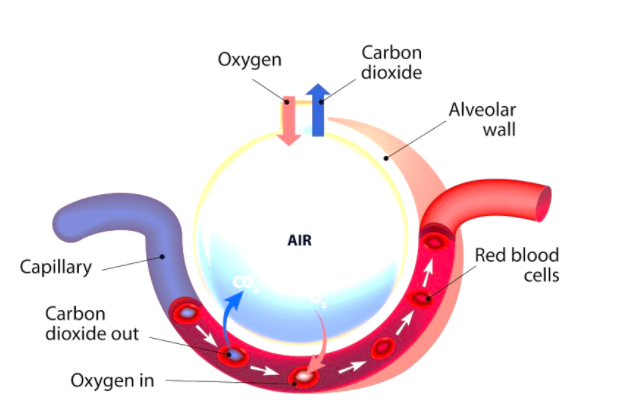
Draw a schematic representation of transport and exchange of oxygen and carbon dioxide in the human body.
Answer
469.2k+ views
Hint:The human body requires oxygen for the process of respiration, it uses up oxygen and in turn produces carbon dioxide that needs to be expelled out of the body.
Complete answer:
The oxygen which is present in the air is inhaled by humans after which it reaches the alveoli of the lungs. Alveoli are very small balloon-like structures that are connected to a network of blood capillaries where the exchange of gases takes place. The oxygen after reaching the alveoli diffuses out into the surrounding capillaries from where it is transported to the entire body. Oxygen can be transported either in the dissolved form or in combination with hemoglobin. In contrast carbon dioxide is brought to the capillaries of the lungs from the body. The form in which carbon dioxide can be transported in dissolved form, as carbaminohemoglobin and as bicarbonate. After they reach the capillary they diffuse to the alveoli from where it is expelled out of the body. The diffusion of oxygen into the capillary and diffusion of carbon dioxide from the capillarity to the alveoli occurs simultaneously and thus is called exchange of gases. The schematic representation of the transport and exchange of oxygen and carbon dioxide is given in the following diagram.

Note:The process of exchange and transport of oxygen and carbon dioxide is of great importance since it helps the oxygen to reach cells where it is needed for various biochemical reactions and also removes carbon dioxide from the body which in higher amounts is toxic.
Complete answer:
The oxygen which is present in the air is inhaled by humans after which it reaches the alveoli of the lungs. Alveoli are very small balloon-like structures that are connected to a network of blood capillaries where the exchange of gases takes place. The oxygen after reaching the alveoli diffuses out into the surrounding capillaries from where it is transported to the entire body. Oxygen can be transported either in the dissolved form or in combination with hemoglobin. In contrast carbon dioxide is brought to the capillaries of the lungs from the body. The form in which carbon dioxide can be transported in dissolved form, as carbaminohemoglobin and as bicarbonate. After they reach the capillary they diffuse to the alveoli from where it is expelled out of the body. The diffusion of oxygen into the capillary and diffusion of carbon dioxide from the capillarity to the alveoli occurs simultaneously and thus is called exchange of gases. The schematic representation of the transport and exchange of oxygen and carbon dioxide is given in the following diagram.

Note:The process of exchange and transport of oxygen and carbon dioxide is of great importance since it helps the oxygen to reach cells where it is needed for various biochemical reactions and also removes carbon dioxide from the body which in higher amounts is toxic.
Recently Updated Pages
Master Class 11 Accountancy: Engaging Questions & Answers for Success

Express the following as a fraction and simplify a class 7 maths CBSE

The length and width of a rectangle are in ratio of class 7 maths CBSE

The ratio of the income to the expenditure of a family class 7 maths CBSE

How do you write 025 million in scientific notatio class 7 maths CBSE

How do you convert 295 meters per second to kilometers class 7 maths CBSE

Trending doubts
10 examples of friction in our daily life

One Metric ton is equal to kg A 10000 B 1000 C 100 class 11 physics CBSE

Difference Between Prokaryotic Cells and Eukaryotic Cells

State and prove Bernoullis theorem class 11 physics CBSE

What organs are located on the left side of your body class 11 biology CBSE

Write down 5 differences between Ntype and Ptype s class 11 physics CBSE




